Rosewood History
Miners at the pithead of a coal mine at Walloon, 1890
Photo: Rosewood Scrub Historical Society
Coal Mines in the Rosewood District
Links
Walloon Coal Mine – Report from the “Week” – 1879
The Minutes of Rosemount Colliery 1937-1940 – Courtesy of Spencer Yarrow
The minimum wage rates for employees in coal mining industry – 10th January 1955
The Last Ipswich Coal Miner – How the Roughrigg Mine opened on the northern slope of Perry’s Knob. – Ipswich First
Map of coalfield – Queensland Department of Mines 1960
Queensland Twenty Chain Series Rosewood Left Mine Map – Geological Survey of Queensland
Ipswich & Rosewood Coalminers Memorial | Monument Australia
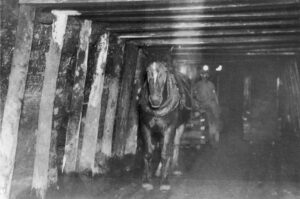
Pit Ponies were used to pull coal wagons where height permitted in the local coal mines.
The photo above was taken in 1920 in Q.C. Gauchalland Mine. (Maryborough Fraser Coast Regional Council)
LIST OF COAL MINES
If you can assist with information about this list, please contact me. hello@rosewoodpasttimes.com
Amberfield 1948 -1955 Amberley Rylance Group
Ardarth 1931-1938 Lanefield
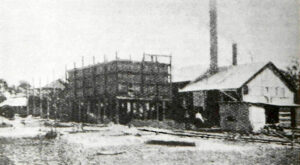
Caledonian – Thagoona Mine
Caledonian 1888 Walloon John Rea’s Shaft (Rea Seam) 1.5 metres thick, and in three sections. By 1900 it was in the hands of John Wright and his partner William Black and the manager was Charles Williams. In 1903 Arthur Boughen was the manager.
Caledonian No 1 1925 -1928 Thagoona
Caledonian No 2 1925-1947
Caledonian No 3 1931-1951
Caledonian No 4 1943-1950
Caledonian No 5 1940-1966
Caledonian No 6 1960-1966
Caledonian No 7 1960-1966
Clarefield Colliery 1924-1928 Thomas Burnside – Half a kilometre west of where Moorlands mine had operated briefly in 1877, on the south side of the Ipswich to Rosewood railway line.
Clarefield Colliery No 2 1937-1930
Clarefield Colliery No 3 1946-1950
Clarkfield Thagoona/Walloon
Clydebank 1921 Walloon It closed three years later after another tunnel had been driven and was probably little more than a prospecting operation.
Clydebank No 2, No 3, No 4 Walloon
Clydebank No 5 (Westvale) Lanefield
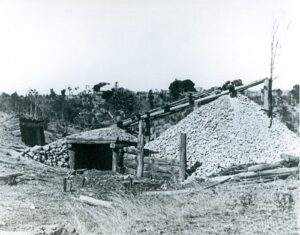
Duckenfield Colliery 1930 Photo: RSHS
Commonwealth Colliery Limited 1903 – Robert Sharp
The intention was to work the same seam as at Moorlands but on the northern side of the railway line. Sharp drove a tunnel to the seam, machinery was purchased and a siding was surveyed, but little more was achieved before the company went into liquidation.
Duckenfield 1925-1928 200 meters west of Westvale Colliery No 2, Lanefield.
1927 – A sports gathering was held in St. Brigid’s School grounds on Saturday afternoon, December 17, organised in aid of Miss Eileen Potts’ candidature in St. Brigid’s Queen Carnival. There was a very good attendance. The chief event of the afternoon was a tug-o’-war, which attracted five teams – Duckenfield Colliery, Caledonian Colliery, Glencoe Colliery, Rosewood Farmers, and Rosewood Sawmill. After some keen struggles the final was fought out between Duckenfield Colliery and Caledonian Colliery. After 15 minutes the judge stopped the contest, and declared it a draw. Duckenfield was represented by Messrs. J. Clement, H. Embrey, J. Uprichard, D. Berlin, C. Yarrow, W. Federer, and W. Embrey. The Caledonian team was Messrs. E. Roberts, A Wright, S. Trewick, W. Buckle, J. McNamara, E. Bell, and P. Bell.
Edenbank 1920 John Hardie opened a small tunnel mine on a low spur of Perry’s Nob east of Rosewood – abandoned in 1925
Excelsior 1910 North Rosewood – Henry Harris
Harris sank a shaft to the Butler Seam for the Ipswich and Rosewood Coal and Coke Company Limited, and laid a tramway to bunkers which he built by the railway line 600 metres away. He took on nine hands and the company circulated optimistic reports about the prospects for their Excelsior Mine. Then Harris suddenly announced that coal production could not commence until a siding had been laid to the railway line. A fortuitous fire destroyed the engine-house and some of the machinery. Harris dismantled the other structures, and the company quietly abandoned the project.
Q.T. 26 May 1911 – Some excitement prevails here owing to the likelihood of the Excelsior Coal-mine being again opened up and fresh developments of a permanent character being made. Mr. W. E. Thomas is now in town selling shares and distributing prospectuses, and is meeting with great success. This mine was closed down some months ago, owing to the difficulty in carting the coal to the railway-line. It is now proposed to sink a shaft almost alongeide the Marburg railway, and this will greatly facilitate the proper working of the mine.
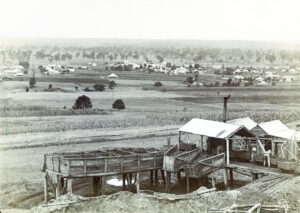
Glencoe Mine early 1920’s
Glencoe No 1 1904 North Rosewood – John Hall (Halls Proprietary Limited) Leased by James Mitchell Bruce (1.2 to 1.5 metres thick, and in three sections). Hall closed the mine about 1908 until such time as the Rosewood-Marburg branch line would be finished, using the intervening time for driving a second (or No.2) tunnel to the seam and building coal bunkers ready for a siding. ROSEWOOD COAL
Glencoe No 2 1911 – The mine reopened in 1911 with Alexander McLean as manager.
Glencoe No 3 1915-1920
Glencoe No 4 1921
Glencoe No 5
Glencoe No 6
Glencoe Extended 1960-1963
Glencoe Extended No 2 1962-1969
Mine Closed at Rosewood. Workings at the Glencoe Colliery Rosewood, which were closed on Monday because of fire, have been sealed off and the tunnel will be abandoned. Some of the miners employed at the pit have received dismissal notices, the Assistant Secretary of the Q.C.E.U. (Mr. R. James) said yesterday. According to union records 25 members are employed at Glencoe. A number of these will be retained to start a tunnel for a new mine and to work on an air shalt. The new tunnel will be driven about 40 yards to the coal seam. It will be reached from the same pit-top as the old workings, but will run at a different angle. Several seams have been worked at Glencoe since the pit was opened about 1904. [Queensland Times, Thursday, 7 August 1952 page 2]
Gowrie Fern Mine 1923-1925 200 metres south of Clydebank.
Haigmoor joined with the three Rosewood Collieries and operated until 26 May 1979.
Jeebropilly Mine 1982-2019 Amberley – New Hope
Lanefield No 1 1918-1927 Situated on O’Donnell’s land
Lanefield No 2 1921
Lanefield No 3
Lanefield No 4
Lanefield No 5 Lanefield
Lanefield Extended Lanefield
Lanefield Extended No 2 Mt Walker Rd, Rosewood
Lanefield Extended No 3 1945-1954 Ebenezer
January 1925 -The Lanefield collieries disposed of their Walloon colliery to the Clydebank Company. Mr. Walter Richardson was then managing at Lanefield.
February 1928 – The proprietors Lanefield Collieries had a light tramway laid down from the colliery to the Lanefield railway station, a distance of about three-quarters of mile. Prior to this horse power had been used for haulage and the colliery had to suspend work during any wet weather owing to the roads being untrafficable.
September 1930 (Brisbane Courier) – A new type of rail motor, invented and constructed by Mr. H. E. Collett, at his motor garage, East-street, Ipswich, has just been completed for the Lanefield Colliery, Rosewood. It was made from a 2½ ton truck chassis, cut in half, and may eliminate the present style of waggon skips, laden with coal, which ave drawn by horses. The motor has a Dodge engine, which is carried on a four-wheel bogey. As the engine runs on a narrow gauge line, all the wheels were specially cast for the job. The brakes are incorporated in the rear wheels, and can be operated by either foot or hand. The deferential has been geared to suit the work. A rough trial of the new motor at the colliery gave every satisfaction. At its first essay it shifted three or four tons of coal without any difficulty and without any sign of over-heating and seems fairly economical to run as regards both petrol and oil. It is expected to be able to pull at least eight tons of coal without any trouble, and should prove much more efficient than the present method of drawing the coal.
Little Jim 1918 – John Mitchell Bruce sank a shaft near the old Commonwealth Colliery east of Rosewood at Lanefield. By 1924 tunnel was in full production. (1.5 metres thick in two sections)
Little John Rosewood
Lowfield No 1 1925-1948 Lanefield – Wass brothers
Lowfield No 2 1938-1951 North Rosewood
Forty miners at Lowfield No. 2 mine, Rosewood, have ceased work on a demand for increased amenities and improved working conditions. Miners at the face have objected to double wheeling of full skips for a distance of 80 yards, which is claimed to be unprecedented in Australian mines. This dispute is the first in the Rosewood district for many years. [Daily Mercury (Mackay), Tuesday 28 September 1948, page 1]
Malabar 1929 Marburg Just north of Roughrigg Collieries, near Mountain Ash No 2.
Malabar Nos 1-10
New Malabar No 1, No 2 All closed 1955
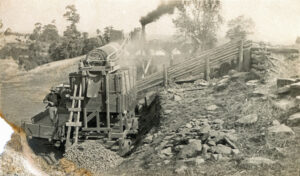
Normanton Colliery No 1
Moorefield No 1, No 2 Walloon
Moorefield No 3 Amberley
Mooreland Coal Pits 1876 Rosewood – Messrs J. & J. Moore Abandoned in 1878.
Mountain Ash No 1 1924-1928 Tallegalla – Mountain Ash Collieries Limited
Mountain Ash No 2 1929-1932 North face of Perry’s Knob.
Mountain View No 1, No 2 Tallegalla
New Mountain View 1945-1949 Tallegalla
Mt Elliott No 1 & No 2 Amberley
Mt Elliott Extended No 1 Amberley
Neath No 1, No 2 1949-1956 Langtons Road
Normanton Colliery No 1 1922-1974 Rosewood
Two local families, the Boughens and the Trewicks, opened a little mine a few hundred metres east of Edenbank in 1922.
Normanton Colliery No 2 1947-1954 Mt Marrow
Normanton Colliery, Rosewood. advised that they intended to make a siding on the down line. They asked for approval to lay a line across the road entering the property of P. Adams. The request was granted, the work to be carried out under the supervision of the Works Committee. [Q.T. Friday. 25 April 1924, pg 7 ]
Oakleigh Perrys Knob – absorbed the Glencoe, Perry’s Nob and Mountain Ash mines.
Oakleigh No 1 1928-1948
Oakleigh No 3 1948 1948-1999 – The Oakleigh Colliery Company began business in 1948 when the Rule family acquired the operation. In November 1973 an open cut mine opened.
Oakleigh No 4 1961-1967
Oakleigh No 5 1984-1999
The New Oakleigh Open Cut Rosewood 1999-25/01/2013
Owned by New Hope. New Hope acquired New Oakleigh from Sumitomo Coal in 1999. The mine closed down all mining activities at the site to focus on rehabilitation work. The reason for the closure was that the mine ran out of coal.
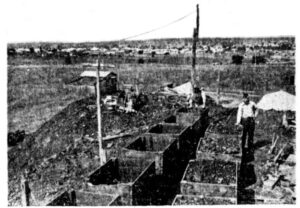
The pit-head of Rosemount Colliery overlooks the town of Rosewood 1949.
Rosemount No 1 1931-1934 Perry’s Knob
Rosemount No 2 1934-1940 In May 1934 a new tunnel was being driven north of Glencoe Colliery at North Rosewood. Proprietors:- E. W. Richardson, C. W. J. Richardson, F. Yarrow and D. A. Berlin. Certificate of Application
Rosemount No 3
Rosemount No 4 1939-1969 Mt Walker Road. Payslip
Rosewood Colliery 1904 Launched by William Andrews, Thomas Murray and Will Haenke. The company financed the sinking of a shaft south of the railway line some 200 metres east of Rosewood railway station, but the thin seam it reached proved unworkable and Haenke was authorised by his partners to liquidate the company.
Rosewood Colliery No 1 1929-1951 (Hardie Seam 1.2 to 1.5 metres thick, and in two sections).
Rosewood Colliery No 2 1940-1971 (John Seam 1.5 metres thick, and in two sections) Closed 1971 and joined with Normanton and United No 8 as one company.
Ponies’ Feeding Time Big Colliery Issue New Coal Loader
Roughrigg 1913 The Cochrane family started Roughrigg Colliery on their property
Roughrigg No 1 1927-1958 Perry’s Knob
Roughrigg No 4 1939-1949
Roughrigg No 5 1955-1969
Roughrigg No 7 1949-1966
Smithfield No 1 1940-1942
Smithfield No 2 1944-1956 Ebenezer
Smithfield No 3 ? -1965 Ebenezer
United No 7 1944-1966 Foot of Evan’s Hill, Tallegalla
United No 8 194? -1972 Perry’s Knob
Walloon Colliery 1877-1887 Smith and Levinge – Half a mile from the Walloon Railway Station. In 1879 the owners were Scott Smith and A. Meston, M. L. A until July 1880 when they dissolved their partnership. Sold to Messrs. Callaghan and Co., of Brisbane. Messrs. T. and J. Johnson leased it.
In December 1879 they discovered a beautiful, rare and valuable fossil specimen in their mine. Karl Staiger, a well-known analyst and assayer, identified it as Araucaria, a conifer tree from the Jurassic period. It was lying on a fragment of bituminous shale, the interstices filled up with sand and dotted with mica scales, and it was lying as naturally and as perfect as when it was deposited there millions of years ago. They presented it to the Queensland Museum.
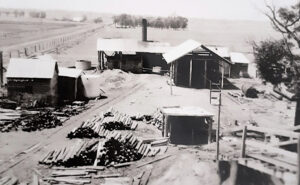
Westvale No 1
Westfalen Thagoona
Westfalen No 1 1932-1948 Mt Marrow
Westvale No 1 1913 Perry’s Knob – Frank Gunthorpe and William Pearn
Westvale No 2 1918-1925
Westvale No 3 1925-1930 Closed at Perry’s Knob then opened at Lanefield.
Westvale No 4 1931-1938 Lanefield
Westvale No 5 1943-1959
Westvale No 6 1941-1953 Lanefield
Westvale No 7 1951-1954 Lanefield
In 1929 the proprietors of Westvale Collieries had a siding, 1½ miles in length, constructed to their pithead at Lanefield, connecting with the main Southern and Western Line about half way between Rosewood and Lanefield. It was put down under the supervision of Mr. W. M. Haenke (for the collieries) and Inspector Provan (for the railways). It was officially opened by Councillor F. J. W. Eichstadt (chairman of the Rosewood Shire Council) in August. Councillor Gunthorpe (manager of the collieries) said that the construction of the siding meant a solution of their transport difficulties which hitherto had been considerably hampered in wet weather, and they were often held up for days and even weeks, when the roads between the collieries and Rosewood station were impassible.
Opening of siding at West Vale Colliery 1929
Incident in Mine. Accused Acquitted 1939
New Diesel Loco at Westvale Colliery 1951
Queensland Times (Ipswich), Wednesday 11 July 1945, page 2
MINES RESCUE SUB-STATION AT ROSEWOOD
Following representations from the Queensland Colliery Employees’ Union and the Queensland Mines Rescue Station, the Mines Department has decided to establish a rescue sub-station at Rosewood. Advice to this effect has been received by the Secretary of the Q.C.E.U. (Mr. Jim Donald) from the Minister for Mines (Mr V. C. Gair).
The establishment of a subcentre was mooted early in the year, and the movement received an impetus following the Woodend disaster on February 1. Late in the same month representatives of the Q.C.E.U. District Executive, the Rosewood miners, and the Committee of Management of the Queensland Mines Rescue Station waited on the Minister for Mines and asked that a centre be ealablished at Rosewood, and that the Bundamba station should be modernised.
The Minister for Mines now has advised Mr. Donald: “I desire to inform you that it would appear that the establishment of a rescue sub-station at Rosewood would meet your requirements. It is proposed to make financial provision on the estimates for the financial year 1945-46 for
(a) The establishment of an auxiliary sub-station at Rosewood, where trainees could be accommodated and partly trained, involving the provision of a building and equipment, expenditure in fees and transport for trainees, and purchase of stores.
(b) A new utility truck to facilitate transport, especially in the direction of training at the Rosewood auxiliary centre.
(c) A new service truck for the Ipswich station.
In the meantime reference is being made to the Committee of Management at Ipswich station as to the provision of the building equipment and motor vehicles, as well as the operating cost at Rosewood after that period. At the same time the committee is being asked for its further view on the matter of telephones at coIlieries and for some definite proposal in that regard.”

This was how coal was loaded at Lanefield Station when coal mines were operating there. Horses were used to pull the small trucks up along rails on the ramp.
© Jane Schy, 2024
